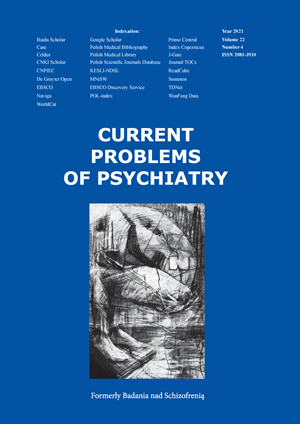Application of metacognitive strategies in the developmentof emotional and motivational self-regulationof students with special educational needs.Research on children with ADHD
DOI:
https://doi.org/10.2478/cpp-2021-0020Słowa kluczowe:
ADHD, strategie metapoznawcze, samoregulacja emocjonalna i motywacyjna, specjalne potrzeby edukacyjneAbstrakt
Celem prezentowanego badania jest weryfikacja, czy metody wizualne (Mapy Myśli i Notatki Wizualne) traktowane jako strategie metapoznawcze pomogą wzmocnić samoregulację emocjonalną i motywacyjną u dzieci z ADHD. W tym badaniu eksperymentalnym wzięło udział 135 uczestników, w tym 45 uczniów szkół podstawowych z rozpoznaniem zespołu nadpobudliwości psychoruchowej z deficytem uwagi z objawami mieszanymi (M = 10,41; SD = 1,42), ich rodzice (N = 45) i nauczyciele (N = 45). Uzyskane w badaniu wyniki wskazują, że dzieci z ADHD popełniają znacznie mniej błędów po 25 sesjach treningowych z wykorzystaniem zarówno Mapy Myśli, jak i Notatek Wizualnych, niż podczas pierwszego pomiaru. Jednak tylko w grupie Notatek Wizualnych znacząco wzrósł średni czas reakcji dzieci, co wskazuje, że są one bardziej refleksyjne. Przedstawione strategie metapoznawcze mogą być z powodzeniem stosowane w szkole przez uczniów z ADHD i stanowią źródło wsparcia zarówno dla uczniów, jak i nauczycieli.
Bibliografia
1. Barnard-Brak L, Stevens T, Albright E. Academic redshirting and academic achievement among students with ADHD. Contemp Educ Psychol. 2017;50:4-12. doi:10.1016/j.cedpsych.2015.10.001
2. Lindsay G, Wedell K, Dockrell J. Warnock 40 Years on: The Development of Special Educational Needs Since the Warnock Report and Implications for the Future. Front Educ. 2020;4:164. doi:10.3389/feduc.2019.00164
3. Ministerstwo Edukacji Narodowej. Specjalne potrzeby edukacyjne dzieci i młodzieży. Prawne ABC dyrektora przedszkola, szkoły i placówki. Warszawa; Ministerstwo Edukacji Narodowej: 2010. https://static.scholaris.pl/mainfile/102/539/specjalne_potrzeby_edukacyjne_66014.pdf. Dostęp 28.12.2021.
4. DuPaul GJ, Langberg JM. Educational Impairments in Children with ADHD. In Barkley RA, ed., Attention-Deficit Hyperactivity Disorder: A Handbook for Diagnosis and Treatment. New York; The Guilford Press: 2015:169-190.
5. Newton KJ, Sperling RA, Martin AJ. Learning disabilities, attention-deficit hyperactivity disorder, and executive functioning: Contributions from educational psychology in progressing theory, measurement, and practice [Editorial]. Contemp Educ Psychol. 2017;50:1–3. doi:10.1016/j.cedpsych.2016.12.003
6. Pinto C, Baines E, Bakopoulou I. The peer relations of pupils with special educational needs in mainstream primary schools: The importance of meaningful contact and interaction with peers. Br J Educ Psychol. 2019;89(4):818–837. doi:10.1111/bjep.12262
7. Roberts W, Milich R, Barkley RA. Primary symptoms, diagnostic criteria, subtyping, and prevalence of ADHD. In Barkley RA, eds., Attention-Deficit Hyperactivity Disorder: A Handbook for Diagnosis and Treatment. New York; The Guilford Press: 2015:51–80.
8. Becker SP, Breaux R, Cusick CN, Dvorsky MR, Marsh NP, Sciberras E,et all. Remote Learning During COVID-19: Examining School Practices, Service Continuation, and Difficulties for Adolescents With and Without Attention-Deficit/Hyperactivity Disorder. J Adolesc Health. 2020;67(6):769–777. doi:10.1016/j.jadohealth.2020.09.002
9. Shah R, Raju VV, Sharma A, Grover S. Impact of COVID-19 and Lockdown on Children with ADHD and Their Families-An Online Survey and a Continuity Care Model. J Neurosci Rural Pract. 2021;12(1):71–79. doi:10.1055/s-0040-1718645
10. Barkley RA. Behavioral inhibition, sustained attention, and executive functions: Constructing a unifying theory of ADHD. Psychol Bull. 1997;121(1):65–94. doi:10.1037/0033-2909.121.1.65
11. Barkley RA. The executive functions and self-regulation: an evolutionary neuropsychological perspective. Neuropsychol Rev. 2001;11(1):1–29. doi:10.1023/a:1009085417776
12. Marx I, Hacker T, Yu X, Cortese S, Sonuga-Barke E. ADHD and the Choice of Small Immediate Over Larger Delayed Rewards: A Comparative Meta-Analysis of Performance on Simple Choice-Delay and Temporal Discounting Paradigms. J Atten Disord. 2021;25(2):171–187. doi:10.1177/1087054718772138
13. Kajka N, Kulik A. The Influence of Metacognitive Strategies on the Improvement of Reaction Inhibition Processes in Children with ADHD. Int J Environ Res Public Health. 2021;18(3):878. doi:10.3390/ijerph18030878
14. Kajka N, Kulik A. Assessment of emotional control from the perspective of young adults with ADHD. Społeczeństwo. Edukacja. Język 14.2 (2021):41-54. doi:10.19251/sej/2021.14.2(4)
15. Barkley RA. Response Inhibition in Attention-Deficit Hyperactivity Disorder. Ment Retard Dev Disabil Res Rev. 1999;5:177-184. doi:10.1002/(SICI)1098-2779(1999)5:3<177::AID-MRDD3>3.0.CO;2-G
16. Kajka N. Uwarunkowania rozwoju społeczno- emocjonalnego dziecka z ADHD w środowisku szkolnym. Problemy Opiekuńczo-Wychowawcze. 2017;2:11-17.
17. Drechsler R, Rizzo P, Steinhausen H-C. The impact of instruction and response cost on the modulation of responsestyle in children with ADHD. Behav Brain Funct. 2010;6:31. doi:10.1186/1744-9081-6-31
18. DuPaul GJ, Anastopoulos A D, Shelton T L, Guevremont D C, Metevia L. Multimethod Assessment of Attention-Deficit Hyperactivity Disorder: The Diagnostic Utility of Clinic-Based Tests. J Clin Child Adolesc Psychol. 1992;21(4): 394-402. doi:10.1207/s15374424jccp2104_10
19. Kagan J. Reflection-impulsivity: the generality and dynamics of conceptual tempo. J Abnorm Psychol. 1966;71(1):17–24. doi:10.1037/h0022886
20. Barkley RA. Impaired delayed responding: A unified theory of attention-deficit hyperactivity disorder. In Routh DK, ed. Disruptive Behavior Disorders in Childhood. Boston; Springer, MA: 1994:11–57. doi:10.1007/978-1-4899-1501-6_2
21. Grossberg S, Seidman D. Neural dynamics of autistic behaviors: Cognitive, emotional, and timing substrates. Psychol Rev. 2006;113(3):483–525. doi:10.1037/0033-295x.113.3.483
22. Duch W, Dobosz K. Sieci neuronowe w modelowaniu chorób psychicznych. W: Tadeusiewicz R, Duch W, Korbicz J, Rutkowski L, eds., Sieci neuronowe w inżynierii biomedycznej. Warszawa; Wydawnictwo Exit: 2013:637-666.
23. Lohman DF, Bosma A. Using cognitive measurement models in the assessment of cognitive styles. In Braun HI, Jackson DN, Wiley DE, eds., The Role of Constructs in Psychological and Educational Measurement. New York; Lawrence Erlbaum Associates Publishers: 2001:127–146.
24. Kajka N. The influence of metacognitive training on the improvement of working memory in children with ADHD. Curr Probl Psychiatry. 2019;20(3):217-227. doi:10.2478/cpp-2019-0015
25. Tamm L, Nakonezny PA. Metacognitive executive function training for young children with ADHD: a proof-of-concept study. Atten Defic Hyperact Disord. 2015;7(3):183-190. doi:10.1007/s12402-014-0162-x
26. Flavell JH. Metacognition and cognitive monitoring: A new area of cognitive–developmental inquiry. Am Psychol. 1979;34(10):906-911. doi:10.1037/0003-066X.34.10.906
27. Pezzica S, Vezzani C, Pinto G. Metacognitive knowledge of attention in children with and without ADHD symptoms. Res Dev Disabil. 2018;83:142–152. doi:10.1016/j.ridd.2018.08.005
28. Pisacco N, Sperafico Y, Enricone J, Guimarães L, Rohde LA, Dorneles BV. Metacognitive interventions in text production and working memory in students with ADHD. Psicol Refl Crít. 2018;31(1):5. doi:10.1186/s41155-017-0081-9
29. Buzan T, Buzan B. The Mind Map Book. London; BBC Books: 1993.
30. Almulla MA, Alamri MM. Using Conceptual Mapping for Learning to Affect Students’ Motivation and Academic Achievement. Sustainability. 2021;13(7):4029. doi:10.3390/su13074029
31. Kalyanasundaram M, Abraham SB, Ramachandran D, Jayaseelan V, Bazroy J, Singh Z, et all. Effectiveness of Mind Mapping Technique in Information Retrieval Among Medical College Students in Puducherry-A Pilot Study. Indian J Community Med. 2017;42(1):19-23. doi:10.4103/0970-0218.199793
32. Kajka N. Trudności w nauce czytania i pisania u dzieci ADHD. Szkoła Specjalna. 2018;3:212-218. http://www.szkolaspecjalna.aps.edu.pl/media/2129755/sz-s_3-18_druk. pdf. Dostęp 28.12.2021.
33. Tanriseven I. A Tool That Can Be Effective in the Selfregulated Learning of Pre-service Teachers: The Mind Map. Aust J Teach Educ. 2014;39(1). doi:10.14221/ajte.2014v39n1.1
34. Joshi CV. Use of Simple Mind Maps in the Adventures of Learning. J Contemp Res Manag. 2017;4(1):1-11.
35. Fernández-Fontecha A, O’Halloran KL, Tan S, Wignell P. A multimodal approach to visual thinking: the scientific sketchnote. Vis. Commun. 2019;18(1):5-29. doi:10.1177/1470357218759808
36. Perry K, Weimar H, Bell MA. Sketchnoting in School: Discover the Benefits (and Fun) of Visual Note Taking. Lanham; Rowman & Littlefield: 2017.
37. Suwa M. Seeing into sketches: Regrouping parts encourages new interpretations. In: Gero JS. eds., Visual and Spatial Reasoning in Design. Sydney; Key Centre of Design Computing and Cognition: 2001:207–219.
38. Tversky B, Suwa M. Thinking with sketches. In: Markman AB, Wood KL eds., Tools for Innovation. Oxford; Oxford University Press:2009:75–85.
39. Conners CK, Rzepa SR, Pitkanen J, Mears S. Conners 3rd Edition (Conners 3; Conners 2008). In: Kreutzer JS, DeLuca J, Caplan B. eds., Encyclopaedia of Clinical Neuropsychology. Springer, Cham.:2018. https://doi.org/10.1007/978-3-319-57111-9_1534
40. Wujcik R, Wrocławska – Warchala E. Conners 3 ®. Zestaw kwestionariuszy do diagnozy ADHD i zaburzeń współwystępujących. Wydanie trzecie. Podręcznik. Warszawa; Pracownia Testów Psychologicznych Polskiego Towarzystwa Psychologicznego:2018.
41. Nietfeld J. Bosma A. Examining the self-regulation of impulsive and reflective response styles on academic tasks. J Res Pers. 2003; 32:118–140. doi:10.1016/S0092- 6566(02)00564-0
42. Matczak A. Test Porównywania Znanych Kształtów (MFF) J. Kagan. Podręcznik. Warszawa; Pracownia Testów Psychologicznych Polskiego Towarzystwa Psychologicznego:1992.
43. Mulligan S. Classroom strategies used by teachers of students with attention deficit hyperactivity disorder. Phys Occup Ther Pediatr. 2001;20(4):25–44.
44. Narad, Megan E et al. “Parent-teacher agreement on ADHD symptoms across development.” Psychological assessment vol. 27,1 (2015): 239-48. doi:10.1037/a0037864
Pobrania
Opublikowane
Numer
Dział
Licencja
Prawa autorskie (c) 2021 Autorzy

Utwór dostępny jest na licencji Creative Commons Uznanie autorstwa 4.0 Międzynarodowe.


